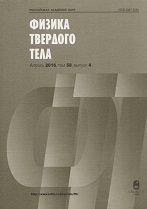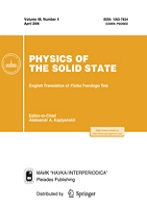|
This article is cited in 8 scientific papers (total in 8 papers)
Semiconductors
Anomalous magnetism of the nanocrystalline oxide TiO2
A. Y. Yermakov, M. A. Uimin, A. V. Korolev, A. S. Volegov, I. V. Byzov, N. N. Shchegoleva, A. S. Minin
Institute of Metal Physics, Ural Division of the Russian Academy of Sciences, Ekaterinburg
Abstract:
The magnetic properties of an oxygen-deficient nanocrystalline undoped titanium dioxide synthesized by the gas-phase, electric-explosion, and chemical method have been studied. The defect state was controlled using reduction treatments in vacuum or in a hydrogen atmosphere. It is shown that the defect state of the surface of nanocrystalline oxides (for example, the existence of vacancies in the anion sublattice and other defects) has a dominant influence on the formation of the magnetic properties of the samples under study. The main contributions to the magnetism of TiO2 nanoparticles after the reduction treatments are the paramagnetic contribution of the matrix, the paramagnetic Curie–Weiss contribution, and the contribution of the spontaneous magnetic moment provided by the existence of regions with different spin ordering. A heterogeneous magnetic state is found to exist in the TiO2 nanopowders; for example, at low temperatures, shifted hysteresis loops are observed as a result of a possible set of magnetic states with different spin orders. It is shown that a soft compaction or grinding of nanopowders in an agate mortar lead to substantial increase in the magnetization, sometimes, by a factor of more than two, regardless of the nanopowder synthesis method and the initial phase state of TiO2 (anatase or rutile structures). This experimental fact proves the key role of the surface defects and the magnetic moment carriers with different spin configurations localized mainly on the nanoparticle surface. The compaction changes the magnetization only in the case when the initial magnetic state has a nonlinear “quasi-superparamagnetic” character of the magnetization curve. As a result of predominant exchange interaction between the nanoparticles with a frustrated character of spin ordering on the nanoparticles surface, the ferromagnetic contribution increases as nanoparticles contact.
Received: 08.08.2016
Citation:
A. Y. Yermakov, M. A. Uimin, A. V. Korolev, A. S. Volegov, I. V. Byzov, N. N. Shchegoleva, A. S. Minin, “Anomalous magnetism of the nanocrystalline oxide TiO2”, Fizika Tverdogo Tela, 59:3 (2017), 458–471; Phys. Solid State, 59:3 (2017), 469–482
Linking options:
https://www.mathnet.ru/eng/ftt9635 https://www.mathnet.ru/eng/ftt/v59/i3/p458
|


| Statistics & downloads: |
| Abstract page: | 54 | | Full-text PDF : | 22 |
|





 Contact us:
Contact us: Terms of Use
Terms of Use
 Registration to the website
Registration to the website Logotypes
Logotypes









 Citation in format
Citation in format 
